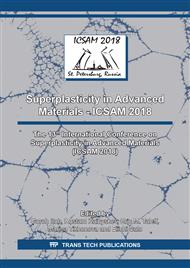p.3
p.9
p.15
p.21
p.27
p.33
p.39
p.45
p.53
On the Nuances in the Power Law Description and Interpretation of High Homologous Temperature Creep and Superplasticity Data
Abstract:
“Power law’’ representation is used to describe minimum creep rate and “steady state” superplastic deformation. In creep isothermal log stress – log strain rate relationship is linear for so long as the rate controlling mechanism remains unchanged. During optimal superplastic flow the slope of this curve changes even when there is no change in the rate controlling mechanism, i.e. the stress exponent, n, at a constant temperature and grain size is a function of strain rate. For a constant rate controlling mechanism, in both the phenomena, n decreases with increasing temperature. Grain size has no effect on creep, but its effect is significant in superplasticity. Therefore, analyzing creep and superplasticity data by treating n for any given mechanism as a constant independent of stress and temperature is questionable. In this analysis stress is normalized with respect to a reference stress, rather than the shear modulus. The microstructure dependence comes through the Buckingham Pi theorem. When contribution from microstructure terms to isothermal strain rate is constant, Laurent’s theorem helps generate a set of values for n. It is shown that the simplest solution, viz. n is independent of stress, but is a linear function of temperature, describes steady state creep. (The case n is independent of both stress and temperature follows as a special case.) The second simplest solution, viz. n is a linear function of both temperature and stress corresponds to steady state superplasticity. Using the equations, the values of n, activation energies for the rate controlling processes and strain rates at different temperatures and stresses could be estimated for both creep and superplasticity. The analysis is validated using experimental results concerning many systems. iiThis lecture is dedicated to the sacred memory of late Prof. Oleg D. Sherby.
Info:
Periodical:
Pages:
27-32
Citation:
Online since:
July 2018
Keywords:
Price:
Сopyright:
© 2018 Trans Tech Publications Ltd. All Rights Reserved
Share:
Citation:


